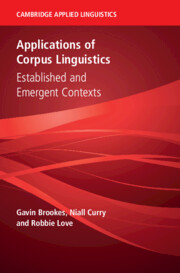Metrics
Full text views
Full text views help Loading metrics...
Loading metrics...
* Views captured on Cambridge Core between #date#. This data will be updated every 24 hours.
Usage data cannot currently be displayed.

Bridging the gap between linguistic theory and practice, this timely book demonstrates the transformative potential of corpus linguistics research and methods across a wide range of contexts. With contributions from a diverse range of authors, this book provides contemporary reflections on both established applications in language education, as well as emergent contexts in which corpus methods are driving social change, such as the media and law. Each chapter provides case studies that clearly demonstrate pathways from theory and analysis to application and impact, making the theory accessible without assuming specialised knowledge of specific contexts. Featuring the development of innovative methods and tools, the book shows readers that corpus linguistics is a discipline attuned to both methodological and societal impact. Showcasing the cutting-edge contributions that corpus linguistics is making to contemporary applied linguistics, this book is essential reading for academics, professionals, and anyone interested in the practical application of language data.
 Loading metrics...
Loading metrics...
* Views captured on Cambridge Core between #date#. This data will be updated every 24 hours.
Usage data cannot currently be displayed.
This section outlines the accessibility features of this content - including support for screen readers, full keyboard navigation and high-contrast display options. This may not be relevant for you.
The PDF of this book complies with version 2.1 of the Web Content Accessibility Guidelines (WCAG), covering newer accessibility requirements and improved user experiences and achieves the intermediate (AA) level of WCAG compliance, covering a wider range of accessibility requirements.
Allows you to navigate directly to chapters, sections, or non‐text items through a linked table of contents, reducing the need for extensive scrolling.
Provides an interactive index, letting you go straight to where a term or subject appears in the text without manual searching.
You will encounter all content (including footnotes, captions, etc.) in a clear, sequential flow, making it easier to follow with assistive tools like screen readers.
You get concise descriptions (for images, charts, or media clips), ensuring you do not miss crucial information when visual or audio elements are not accessible.
You get more than just short alt text: you have comprehensive text equivalents, transcripts, captions, or audio descriptions for substantial non‐text content, which is especially helpful for complex visuals or multimedia.
You will still understand key ideas or prompts without relying solely on colour, which is especially helpful if you have colour vision deficiencies.
You gain clarity from ARIA (Accessible Rich Internet Applications) roles and attributes, as they help assistive technologies interpret how each part of the content functions.